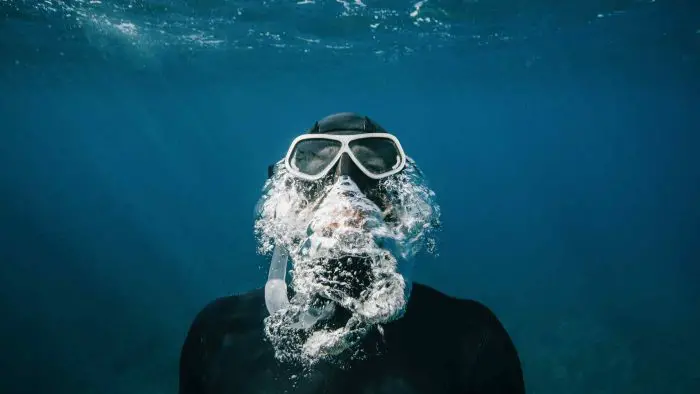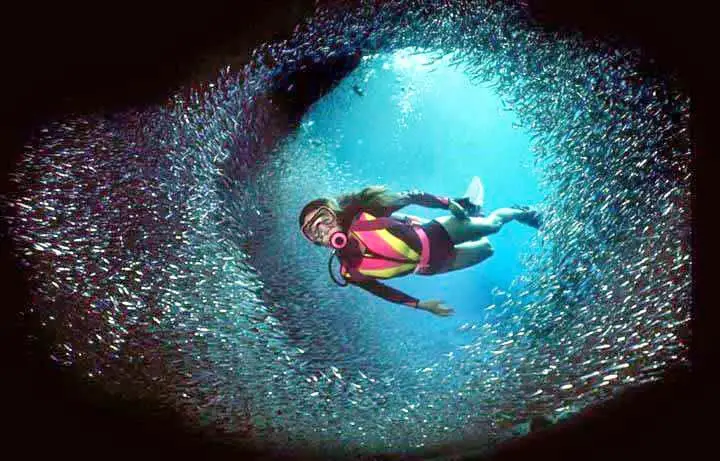Diving is an activity that is on almost everyone’s bucket list. There is nothing more exciting than the prospect of heading underwater and investigating all of the hidden wonders of sea life. However, diving is much more than just plummeting into the water and exploring. In fact, there is a strict list of guidelines that you must follow to ensure your safety and general limitations put in place by nature itself.
One of the main reasons that a lot of people avoid diving is because they aren’t educated about the limits that come alongside it. One of the biggest questions that people have when it comes to diving is how deep can a scuba diver go without being injured or crushed by the weight of the water.
How deep can a Scuba Diver Free-dive

Before we get into the exact depth that a human can dive before being crushed, we should first go over how far a scuba diver can free-dive. Free-diving is basically diving but without all of the scuba gear that is usually used when going on deeper dives. It is essential to cover this before we go into the risks of diving with scuba equipment, as people often believe that the two share the same limitations, which really isn’t the case.
The human body is actually much more remarkable than you may think, and we are capable of much more than just a couple of meters without scuba gear assistance. In fact, we are capable of diving over one hundred meters unassisted. Obviously, this would depend on the person and a vast amount of practice, but it is entirely possible to do. There is a reflex called the mammalian diving reflex in each of us, which means the way our bodies work changes when we are free-diving.
When free-diving, there should be no concern about being crushed by the pressure of the water, as it would be impossible to be able to reach the necessary depth without a long line of scuba equipment.
How deep can you dive before being crushed?
Being crushed by the pressure of water is not really that common of an issue due to the vast depths you would have to travel to for it to occur. You would have to dive to around 35.5km of depth before you were crushed because human bone crushes at approximately 11159kg per square inch, which is pressure that you wouldn’t experience in a casual dive. The bodies of water that we have on earth don’t even reach that depth, so theoretically, you could explore the seabed of several oceans before even feeling slight compression.
The water in our bodies

When we talk about bodies being crushed due to depth, we don’t just mean that there will be immediate internal combustion as soon as you reach a certain depth. In fact, it works a lot different than that. Though at 35.5km, your actual bones will be crushed, the main issue that you will face is air compression. Luckily, the body is around about 60% water, which is in-compressible, which means that our vital organs would be safe. However, the pressure of investigating large depths would affect our airwaves.
Equalizing
Something that divers do in order to avoid damage is equalizing. This is basically compensating for static water pressure by using other sources of oxygen, such as gas tanks. However, it is possible to reach depths where the pressure makes it virtually impossible to complete equalization when diving.
Oxygen toxicity
When diving and attempting to equalize, divers can experience oxygen toxicity. This occurs when you go below a depth of around 60ft and begin to exceed your usual oxygen consumption, which can be toxic. This can lead to seizures and even drowning and is something to keep in mind when diving.
Other safety issues
Though you are unlikely to experience the feeling of being crushed under the pressure of water when diving, there are a number of other safety issues that you should take into consideration when diving that could compromise your health and even kill you.
Sea life
Something that is often forgotten when focusing on the risks of diving is the risks that sealife can pose. This becomes more of an issue when you go deeper, as some of the ocean’s largest predators choose deeper depths for prey. Divers’ primary worry is sharks, the ocean’s most hazardous predator. Sharks are a common enemy in most popular diving films, so this makes sense. Though this isn’t true for most regions, deep-sea divers should be aware of sharks.
Most driving instructors will take you diving in a location that is clear of sharks, but sharks are unpredictable creatures and can really swim wherever they want. Because of this, it is important that you take any precautions that you can to avoid being their next meal. First of all, you should avoid wearing colors that attract sharks, such as whites and silvers that may make you appear as a sea lion. You should also know how to act if you find yourself in a position where you see a shark. The first thing you should do is return to the surface of the water and get into your boat, as they are not likely to attack that.
Decompression limits

An easy mistake that even the most experienced divers have made is not planning out your decompression limits. When you are diving, it is easy to get lost in the amazement of your surroundings and travel further or deeper than you had initially planned. This can be highly detrimental to your health as this could disrupt your previously planned compression limits, which ensure you are receiving a steady amount of oxygen. If you don’t go too deep, then the most you will experience is decompression sickness or the ‘bends,’ which will make you feel a bit unwell. However, if you go further, you could limit your own oxygen and make yourself unwell.
